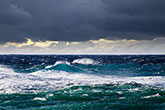Saab Seaeye Falcon ROV helps in drifting iceberg research
Thanks to research from the Memorial University of Newfoundland, rigs at risk from drifting icebergs can expect an early warning.
Modelling the behaviour of icebergs
The Autonomous Ocean Systems Laboratory (AOSL) at the University is undertaking a long-term study into modelling the behaviour of icebergs that includes acquiring real-world data that will increase the accuracy of predicting the rate and direction of their drift.
They are also finding ways to identify exceptionally deep icebergs that might drag across the seabed in shallow water and damage pipelines.

Laboratory Director Dr. Ralf Bachmayer (right) and PhD student Brain Claus preparing the Falcon for an AUV retrieval mission – one of its roles at AOSL.
Saab Seaeye Falcon ROV
Specially designed autonomous vehicles are being developed for the role. Fitted with ice profiling sonar they will stay with an iceberg for 28 days at a time gathering data on ice thickness and volume – as well as direction and drift.
To help evaluate systems planned for use on the unmanned autonomous vehicles, AOSL is using a Saab Seaeye Falcon ROV as a development platform.
Neil Riggs, Senior Project Manager at AOSL, says the Falcon is a valuable development tool for helping understand how various payloads will behave when attached to autonomous vehicle systems.
R&D support system
“It was recognised at an early stage that in order to be effective in performing R&D for autonomous systems we needed an ROV tool. The acquisition of the Falcon resulted from a careful examination of the available alternatives. It was judged the Falcon suited our needs extremely well. It is a very good R&D support system for us.”
The university already deploys the Falcon for a range of tasks that include utility search and recovery and for training pilots in ROV operating.
Safeguarding operations from icebergs
The current AOSL project will significantly increase observational capabilities of the underwater environment in harsh ice-covered and iceberg infested environments offshore eastern Canada and in the Arctic. The range of real time data gathered will be extensive as it identifies above and below water shapes of icebergs; maximum keel shape, depth and ocean surface current field; surface to bottom current profiles; and weather in the vicinity of icebergs.
Adapted from press release by Cecilia Rehn
Read the article online at: https://www.oilfieldtechnology.com/exploration/21112014/saab-seaeye-falcon-rov-helps-in-drifting-iceberg-research/
You might also like
bp begins oil production from major new platform offshore Azerbaijan
bp, as operator of the Azeri-Chirag-Gunashli (ACG) project, has announced the start-up of oil production from the new Azeri Central East (ACE) platform as part of the ACG field development in the Azerbaijan sector of the Caspian Sea.


